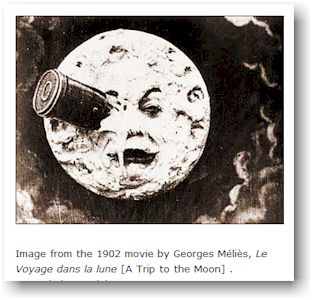From the Earth to the Moon
(From the Fort Ward Dispatch (Alexandria,
VA), Winter 2006)
Rarely is the Civil War considered a source for works of science fiction, but in the case of Jules Verne's From the Earth to the Moon, it was the Union artillerymen who inspired the famed French author to create the 1865 classic. Wondering what would become of the skilled gunners after the American conflict was over, Verne gave them a new target -- the moon.
In a nexus of Civil War events, technology and literature, Jules Verne drew upon these interests to create a topical narrative. Writing during some of the worst battles of the American Civil War, Verne, the pioneer of science fiction and the most-translated novelist in the world, had great admiration for the Union soldier. "The Yankees, the world's best mechanics, are engineers the way - that Italians are musicians and Germans are metaphysicians - by birth."
Verne created the fictional post-war Baltimore Gun Club, membership restricted to persons who had invented or improved cannons and other forms of firearms, or had served as artillerymen. At the opening of the book, the retired artillerymen are wistfully recalling their war days: "...one sad and wretched day, the survivors of the war made peace. The shooting gradually died down; the mortars fell silent; muzzled howitzers and drooping cannons were taken back to their arsenals; cannon balls were piled up in parks; bloody memories faded... mourning clothes and the grief they represented began to wear thin and the Gun Club was plunged into idle boredom." One of the members laments, "Those days are gone. How wonderful they were! You could invent a howitzer and try it out on the enemy as soon as it was cast, then when you came back to camp you'd get a word of praise from Sherman or a handshake from McClellan! But now the generals have become shopkeepers again and balls of yarn are the deadliest projectiles they're likely to deal with."

The flamboyant Gun President, J.P. Barbican, announces a new target for the former artillerymen -- the design and firing of a cannon that will launch a rocket to the moon. The proposal is greeted by a worldwide resurgence of interest in the moon, astronomy and the methods employed by gunners. "The artillery projectile is the most brilliant manifestation of human power, " says one character. In writing his novel, Verne demonstrates detailed knowledge of weaponry and artillery tools, describing the merits of various materials and castings, gun carriages, bores and projectile ranges. The narrative continues, bolstered by scientific observations of the day, a fund raising campaign to finance the launch, daring wagers, a search for the launch site, and eventually, a manned space flight.
Verne doesn't miss the opportunity to compare wartime and peacetime uses of American technology, though. A French daredevil who has volunteered for the voyage makes the point. "His greatest pleasure was to tell those staunch artillerymen that they were nothing but charming and skillful murderers. He constantly made jokes on the subject. When he visited the cannon, he admired it greatly and went down to the bottom of the gigantic tube that would soon send him on his way to the moon. 'At least this cannon won't hurt anyone,' he said, 'and that's a rather amazing quality for a cannon. But as for your weapons that destroy, burn, shatter and kill, I don't even want to hear about them.' "
Verne's work on the American Civil War artilleryman has stood the test of time as a novel and a work of science. Like his first novel Five Weeks in a Balloon (1863) and Journey to the Center of the Earth (1864), From the Earth to the Moon is characterized by a spirit of adventure, scientific content as an integral part of the story, and a setting based on current events. One of the earliest works in the science fiction genre, From the Earth to the Moon was the first Jules Verne novel to be made into a movie (1903), and was also the inspiration for the Space Mountain amusement ride at Disneyland Paris. Contemporary scientists at NASA and the U.S. Centennial of Flight Commission marvel at Verne's ability to anticipate details about space travel 104 years before man landed on the moon and when only eight planets were known. Despite the lack of general knowledge about space travel or belief that it could even be accomplished, Verne's calculations for his giant cannon were amazingly close to those needed to launch the Apollo missions in the 1960s, including a Florida launch site, a three-man crew, and an ocean splashdown. Even the moniker of Verne's cannon, The Columbiad, would foreshadow the name of the Apollo 11 command module, the Columbia.
Replete with canny predictions about space flight more than one hundred years in the future, and unabashed admiration for the artilleryman, this optimistic adventure tale appealed to the 1860’s public's intense interest in Civil War activities. In doing so, Verne created a new genre for youth and adult fiction with roots in American history.
